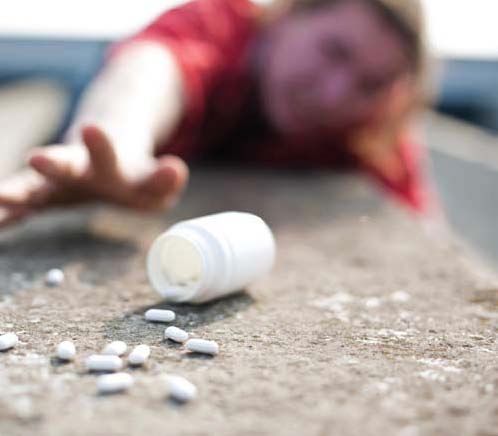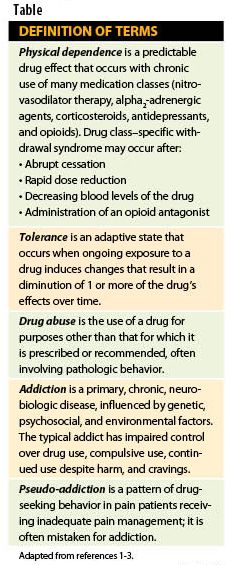Publication
Article
Pharmacy Times
Drug Abuse: A Far-Reaching Reality
Author(s):
Proper pain assessment is critical when considering the appropriate prescribing and dispensing of prescription drugs for pain, because these agents carry a high risk of abuse and misuse.

Over the past 20 years, clinicians and regulators have struggled to reach consensus on an important issue: What constitutes appropriate prescribing practices in medically ill populations with respect to prescription drug products that promote healing and reduce human suffering, but have the potential for abuse? The emphasis is on ideal pain management. For most severe, nonmalignant chronic pain and cancer pain, opioids have become the cornerstone of management, creating this quandary: How can we treat pain and other conditions while making every effort to avoid potential abuse and diversion?
The cornerstone of appropriate prescribing is good patient assessment. Done properly and thoroughly, comprehensive assessment can help prescribers identify patients who are seeking prescriptions for recreational or self-treating use, or other aberrant drug-taking behavior. Prescribers need a risk management paradigm that includes risk assessment and stratification, especially when they plan to employ opioids.1 Regardless, some patients develop abuse issues despite our best efforts.

We currently lack a simple, uniform terminology to describe pain management, addiction, and abuse. Many clinicians tend to use the terms “abuse” and “addiction” interchangeably, and may be unaware or unappreciative of “medication tolerance” and “physical dependence” (Table).1-3 These terms were originally developed to describe medically healthy populations, but we increasingly use them to describe medically ill patients who have coexisting substance abuse.4
What’s Out There?
The number of prescriptions for analgesics has increased globally. For example, prescriptions for opiates increased from approximately 40 million in 1991 to almost 180 million in 2007, with US prescriptions accounting for 99% of all hydrocodone and 71% of all oxycodone. In the United States, hydrocodone compounds are routinely among the top 5 prescribed medications according to annual reports.5,6 In just 3 years (2002 2005), American physicians prescribed 9.4 billion doses of opioids.7 An unknown number of these doses were diverted. Whenever patients present prescriptions for drugs with abuse potential, pharmacists need to stress adherence and proper storage. According to the National Institute for Drug Abuse’s “Monitoring the Future” study, 7 of the 11 drugs most commonly abused by high school seniors are either prescribed or purchased over the counter.8 Every day, other prescription products are developing reputations for abuse. Recent reports indicate that some people are abusing quetiapine, a drug that does not have the classic characteristics associated with abuse. It appears that abusers like its sedating and anxiolytic effects. 9-11 Abusers and addicts also seek naltrexone, often to selfmedicate for alcohol abuse and addiction using the Sinclair Method.12 This method decreases cravings for alcohol without prior detoxification, but few practitioners use it. The word that there is a method that decreases cravings without the discomfort of withdrawal, fortified with ample information on the Internet,2 spreads like wildfire in the abuser community.
The bottom line is something like this: horticulturalists define a weed as any plant growing where you do not want it. A drug of abuse is any drug an abuser wants, including OTCs, regardless of the reason. During counseling, all pharmacists need to be alert for potential abuse situations.
Who’s Looking?
Two types of patients are of greatest concern in terms of drug diversion: addicts and abusers. Also known as “nonmedical users,” these are drug seeking individuals who self-treat personal issues, are recreational users, or have a more severe or chronic substance use disorder or addiction. Patients who have medical needs are more complicated, as they alter the way they take a drug in order to chemically cope with their illness or, rarely, become addicted. Often, their behaviors are simple nonadherence.13 Prescribers must also document their prescribing rationale well, lest they be flagged as facilitating addiction or abuse. Pharmacists must be direct with these patients, and explain how to take the medications and the

repercussions of nonadherence.
When unconventional prescribing is a necessity for a unique patient, prescribers should document carefully. Among the reasons that prescribers may have to change a patient’s dose to a level that raises red flags are: a painful condition’s aggressive progression; the development of a difficult comorbidity; the presence of tolerance or pseudo-addiction; increased suffering in general; drug interactions; and a patient’s unique metabolic changes due to genetics, diet, or exercise.14,15 Prescribers do not always think ahead and let the pharmacist know why they are making what seems like a startling change. Pharmacists should call prescribers and document when they see unconventional prescriptions and have not been made aware of the reasons.
Handling Possible Abusers
Once it appears that abuse is an issue, the best action will depend on the individual patient’s situation. Some options include:
• Reevaluation of the patient’s clinical situation, including how the abuse developed and over what period of time, to determine if further workup is needed
• Referral to a specialist
• Adding physical therapy or alternative medicine approaches
• Considering investigational treatments
• Changing the type (eg, short-acting to controlled release) or route of administration of a medication
• Investigation into adherence issues (such as where medications are stored and others’ access to them)
• Improved/enhanced and interdisciplinary patient monitoring
• Use of a drug contract with the patient1,13-16
When the abuser is a pharmacist, the situation can be complex and require careful handling (Sidebar).
End Note
There is always a possibility that prescribing a legitimate drug could contribute to drug abuse and diversion. The pharmacist may be the first to notice when a medical user of a prescription drug is abusing it. The classic signs are early refills, “lost” prescriptions, and physician shopping. The pharmacist who is knowledgeable about alternative treatments and abusedeterrent products can be an asset on the multidisciplinary team. PT
References:
1. Starr TD, Rogak LJ, Passik SD. Substance abuse in cancer pain. Curr Pain Headache Rep. 2010;14:268-75.
2. Kirsh KL, Whitcomb LA, Donaghy L, Passik SD: Abuse and addiction issues in medically ill patients with pain: Attempts at clarification of terms and empirical study. Clin J Pain 2002, 18(4 Suppl):S52—S60.
3. Anonymous. The Sinclair Method. Available at: www.thesinclairmethod.net/community/. Accessed June 24, 2010.
4. Liaison Committee on Pain and Addition. Definitions relating to the use of opioids for the treatment of pain. 2001. Available at: www.ampainsoc.org/contents/. Accessed June 24, 2010.
5. Lamb E. Top 200 Drugs of 2008. Available at: www.pharmacytimes.com/issue/pharmacy/2009/2009-05/RxFocusTop200Drugs-0509. Accessed June 24, 2010.
6. Bartholow M. Top 200 drugs of 2009. Available at: www.pharmacytimes.com/issue/pharmacy/2010/May2010/RxFocusTopDrugs-0510. Accessed June 24, 2010.
7. United States Department of Health and Human Services: The National Survey on Drug Use and Health (NSDUH) Report: Patterns and Trends in Nonmedical Prescription Pain Reliever Use: 2002 to 2005. Available at: www.oas.samhsa.gov/2k7/pain/pain.htm. Accessed June 24, 2008.
8. Volkow ND: Scientific research on prescription drug abuse, before the Subcommittee on Crime and Drugs, Committee on the Judiciary and the Caucus on International Narcotics Control United States Senate. Available at: www.drugabuse.gov/Testimony/3-12-08Testimony.html. Accessed April 2010.
9. Sansone RA, Sansone LA. Is seroquel developing an illicit reputation for misuse/abuse? Psychiatry (Edgmont). 2010;7:13-6.
10. Galyuk TM, de Backer G, de Jong CA, Beers E, Loonen AJ. [Abuse of quetiapine. Two addicted patients with borderline personality disorder]. Ned Tijdschr
Geneeskd. 2009;153:674-6.
11. Reeves RR, Brister JC. Additional evidence of the abuse potential of quetiapine. South Med J. 2007;100:834-6.
12. Boening JA, Lesch OM, Spanagel R, Wolffgramm J, Narita M, Sinclair D, Mason BJ, Wiesbeck GA. Pharmacological relapse prevention in alcohol dependence: from animal models to clinical trials. Alcohol Clin Exp Res. 2001;25(5 Suppl ISBRA):127S-131S.
13. Passik SD, Kirsh KL: The interface between pain and drug abuse and the evolution of strategies to optimize pain management while minimizing drug abuse. Exp Clin Psychopharmacol 2008;16:400—404.
14. Pappagallo M: The concept of pseudotolerance to opioids. J Pharm Care Pain Symptom Control 1998;6:95—98.
15. Smith HS: Variations in opioid responsiveness. Pain Physician 2008;11:237—248.
16. Ballantyne JC, Mao J: Opioid therapy for chronic pain. N Engl J Med 2003, 349:1943—1953.
17. Haythornthwaite JA, Menefee LA, Quatrano-Piacentini AL, Pappagallo M: Outcome of chronic opioid therapy for non-cancer pain. J Pain Symptom Manage 1998, 15:185—194.
18. Raja SN, Haythornthwaite JA, Pappagallo M, et al.: Opioids versus antidepressants in postherpetic neuralgia: a randomized, placebo-controlled trial. Neurology 2002, 59:1015—1021.
19. Kenna GA, Wood MD. Alcohol use by healthcare professionals. Drug Alcohol
Depend. 2004 Jul 15;75(1):107-16. PubMed PMID: 15225894.
20. Kenna GA, Lewis DC. Risk factors for alcohol and other drug use by healthcare
professionals. Subst Abuse Treat Prev Policy. 2008 Jan 29;3:3. PubMed PMID:
18230139; PubMed Central PMCID: PMC2265282.
21. Baldisseri MR. Impaired healthcare professional. Crit Care Med. 2007;35(2 Suppl):S106-16.







